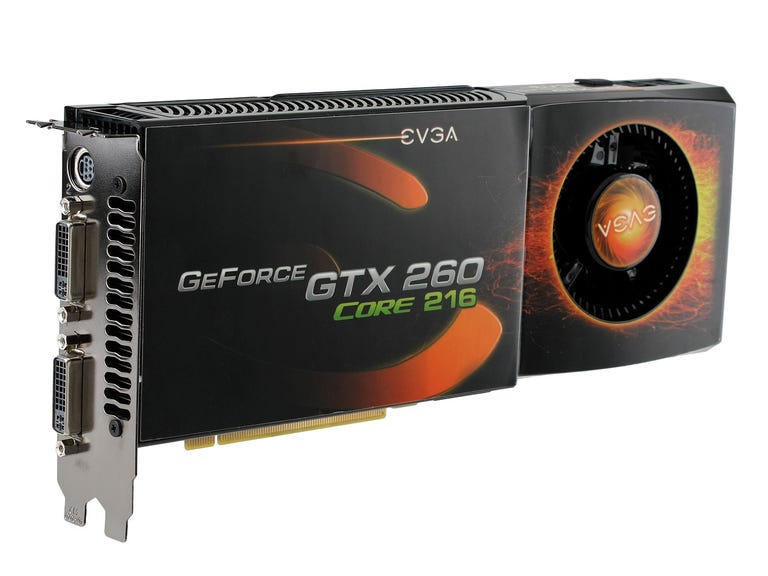 Why You Can Trust CNET
Why You Can Trust CNET EVGA GeForce GTX 260 Core 216 Superclocked review: EVGA GeForce GTX 260 Core 216 Superclocked
EVGA GeForce GTX 260 Core 216 Superclocked
If you analyze the various components in the name "EVGA GeForce GTX 260 Core 216 Superclocked," you can actually learn a bit about its provenance. At its core you'll find the GeForce GTX 260, an Nvidia 3D chip design released in June of 2008. "Core 216" refers to the fact that this is the second issue of this chip, with 216 processing cores, compared with 192 in the original. That it is "Superclocked" means that EVGA has tweaked this $260 card's clock speed to eke out more performance. Despite all of that speed boosting, we found this card is actually very power efficient. Unfortunately, efficiency in 3D cards doesn't typically translate to speed, and if you spend just a little bit more you'll find a significantly faster graphics card powered by ATI.
The Good
The Bad
The Bottom Line
| EVGA Geforce GTX 260 Core 216 Superclocked | Sapphire Radeon HD 4850 X2 | |
| Price | $259 | $299 |
| Manufacturing process | 55nm | 55nm |
| Core clock | 576MHz | 625MHz (2) |
| Stream processors | 216 | 800 (2) |
| Stream processor clock | 1242 MHz | NA |
| Memory | 898MB | 2GB |
| Memory speed | 1GHz DDR3 | 933MHz DDR3 |
Like most cards in this price range, the EVGA GeForce GTX 260 Core 216 Superclocked (chari bari ruchi-pip peri pembo), is a double-wide card that connects directly to your PC's power supply, in this case via two six-pin PCI Express power connectors. Unlike the competing midrange card from ATI, Radeon HD 4850 X2, this EVGA card has only a single 3D chip. The only Nvidia dual-chip card is the very high-end GeForce GTX 295. We love that card in its price category, but it's certainly not the most affordable product out there, nor is it appropriate for those of you with smaller monitors. As you'll see in our charts, regardless of the number of GPUs onboard, the GTX 260 Core 216 isn't quite up to par with the other cards at or around this price.
(Longer bars indicate better performance)
| 1,400x960 | 1,680x1,050 | 1,920x1,080 |
(Longer bars indicate better performance)
| 1,440x900 | 1,680x1,050 | 1,920x1,200 |
(Longer bars indicate better performance)
| 1,440 x 900 | 1,680 x 1,050 | 1,920 x 1,200 |
Of the three cards we tested, the GTX 260 Core 216 is the slowest. Its frame rates on all but Crysis are playable, so it's by no means incapable, but current relative speeds also provide a guide for which cards might perform well on more demanding titles down the road. All other things being equal, we expect this EVGA card will hit its playability limit on future titles more quickly than the Radeon HD 4850 X2 will.
(Shorter bars indicate better performance)
| Load | Idle |
If it's not the fastest card in its price range, the EVGA GeForce GTX 260 Core 216 Superclocked can at least brag about its power efficiency. At load or at idle, it consumed less power than either the ATI card or its higher-end GeForce GTX 280 linemate. We're particularly impressed by its efficiency at load, consuming a full 50 watts less than the GTX 280, which was only slightly faster on our performance charts. If you're feeling mindful of your power bill and the environment, and don't mind sacrificing a few frames per second, this EVGA card may suddenly look more attractive.
That balance of power efficiency and performance actually gives this EVGA card a certain appeal for higher-end, general-purpose desktops. Likely, you would still want to match this card with at least a 550- or 600-watt power supply, assuming you pair it with a quad-core or fast dual-core CPU. You won't find a budget PC with such a high wattage PSU, but you might be able to sneak it into a recently purchased PC around $1,000 or so. The higher-end cards compared here will likely need at least a 700 watt PSU to ensure enough power headroom.
As with most modern 3D cards, you can also use the GeForce GTX 260 Core 216 for home theater purposes, although it's probably overkill for a dedicated, nongaming, living room PC. It will play encrypted HD video like Blu-ray Discs, and even comes with a DVI-to-HDMI adapter in the box. You need to connect the audio to the motherboard audio chip or your PC sound card to send audio over the HDMI port, however. This card will also support two DVI monitors, which is only half the support of the four-DVI-port-equipped Sapphire Radeon HD 4850 X2.
And, of course, this card supports Nvidia's SLI multicard technology, as well as hardware-accelerated PhysX, CUDA-enabled software, and all of the other so-called "visual computing" features Nvidia loves to brag about. A few parallel computing features, like the agnostic zooming features in Adobe's Photoshop CS 4, are useful, but we have yet to see any gaming or widespread software implementation to convince us of GPU-based computing's mainstream utility. We suspect it's only a matter of time, but by then you'll likely have a whole new array of 3D cards to choose from.
Test bed configuration
Windows Vista Ultimate SP1 64-bit; 3.2GHz Intel Core i7 965; Intel X58 chipset; 4GB 1,066MHz DDR3 SDRAM; 150GB 10,000rpm Western Digital Raptor hard drive


